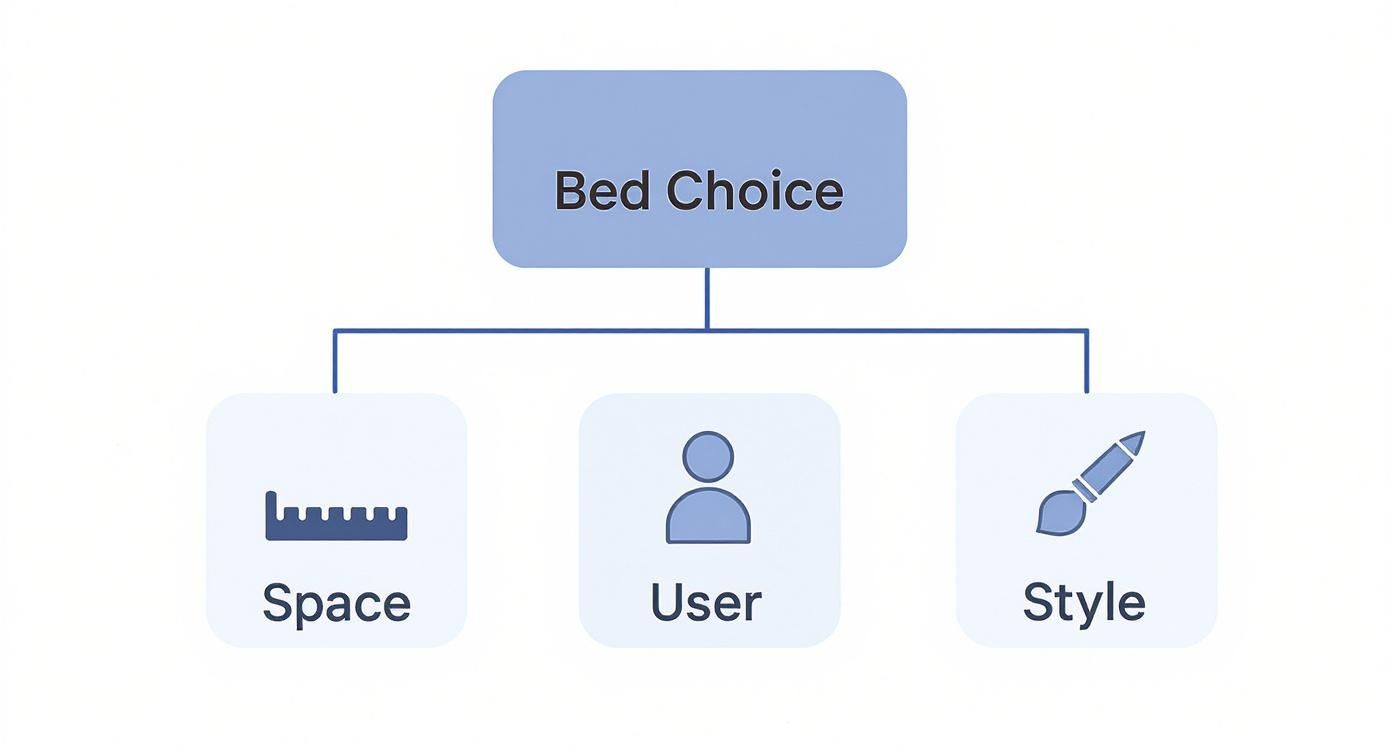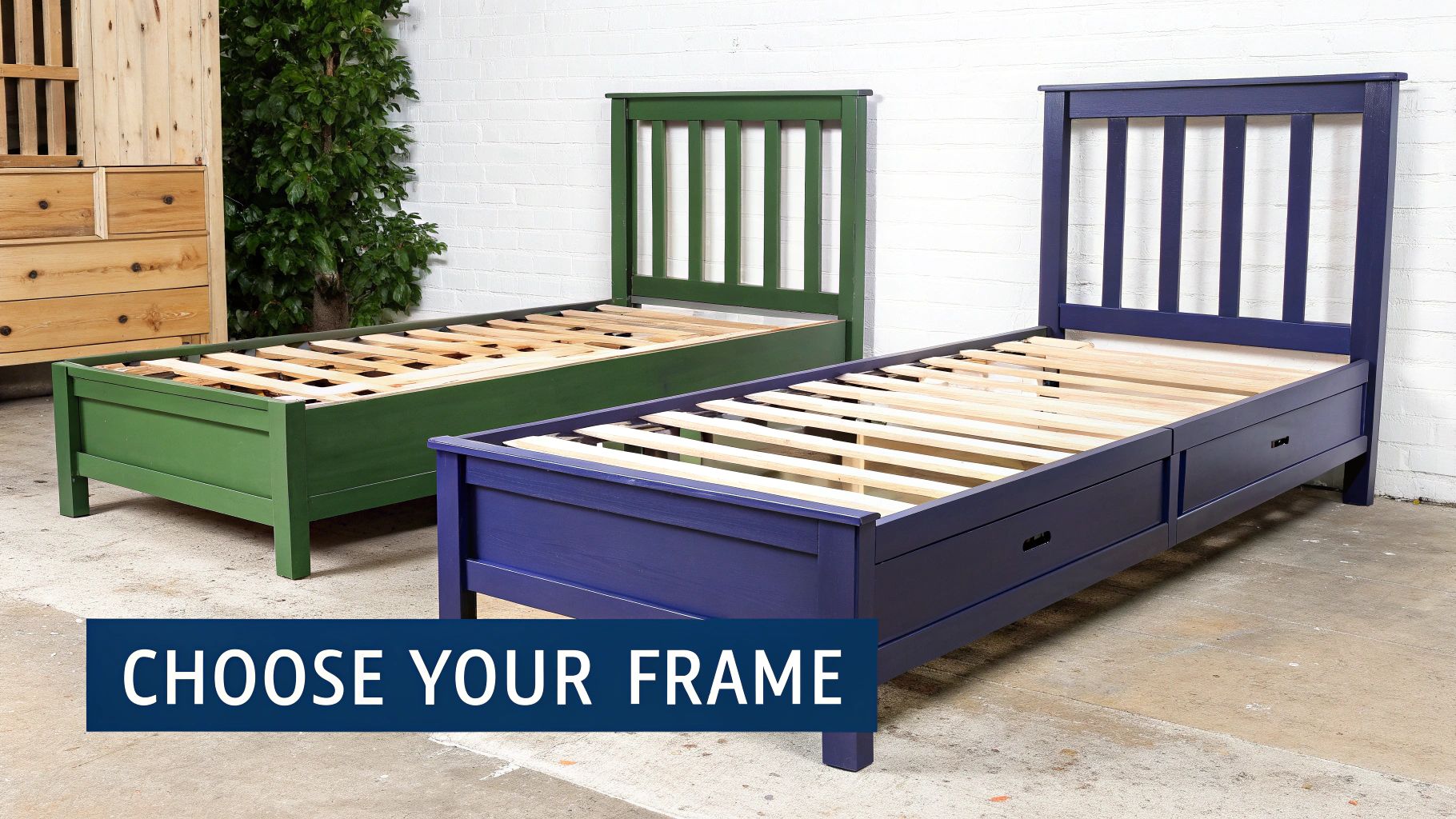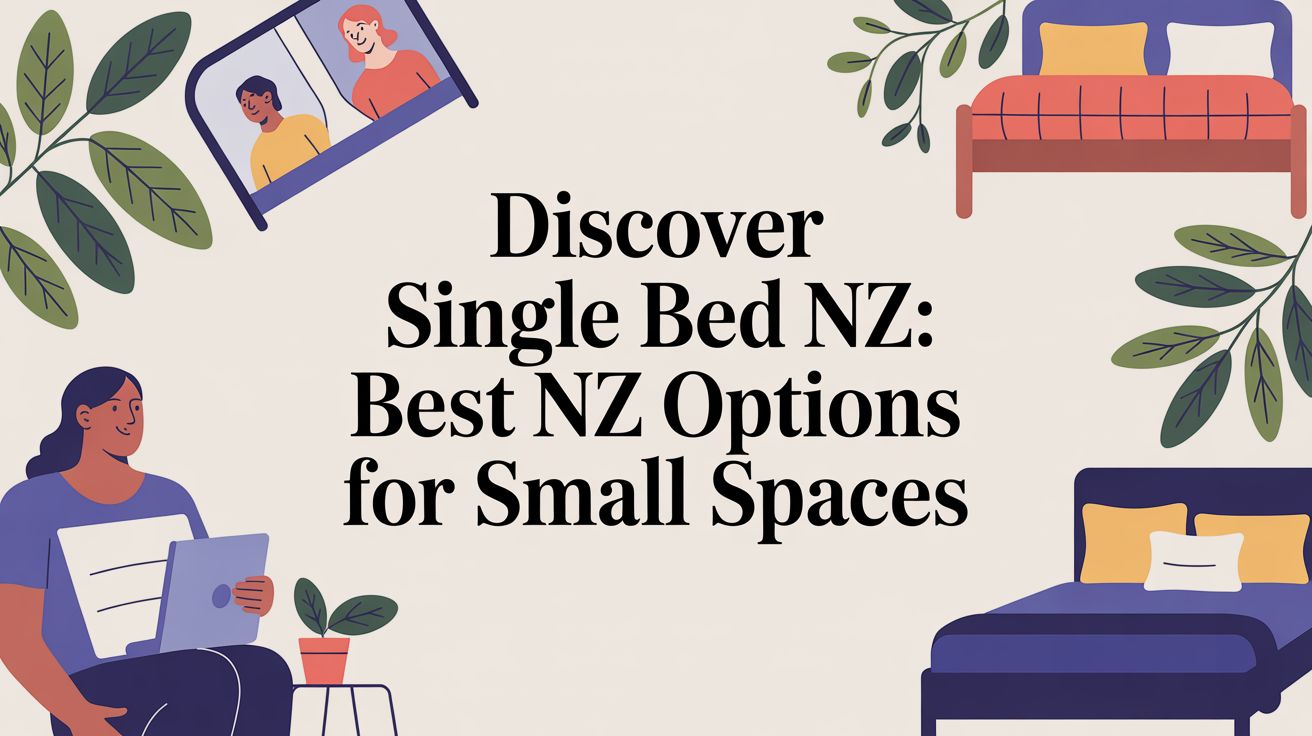So, you're on the hunt for the perfect single bed in NZ. Whether you're upgrading your child to their first 'big kid' bed, kitting out a guest room, or making the most of a cosy apartment, it's a bigger decision than it seems. The right bed doesn't just fill a space; it transforms it.
This guide is designed to cut through the jargon and give you practical, straightforward advice. We'll walk you through everything you need to know, from decoding Kiwi bed sizes to choosing a mattress that guarantees a great night's sleep. Let's get started.
Your Guide to Choosing the Right Single Bed
Finding the right single bed in NZ is about more than just ticking a box. It's an investment in comfort, smart use of space, and the overall feel of a room. With so many options out there—from different frame materials and mattress types to navigating our unique Kiwi bed sizes—it's easy to feel a bit overwhelmed.
Think of this as your friendly roadmap. We'll start with the basics to get you up to speed, then dive into the finer details. My goal is to give you the confidence to choose a bed that perfectly fits your space, budget, and comfort needs.
What You Will Learn in This Guide
I'll walk you through everything you need to know, breaking it all down into simple, easy-to-digest pieces. We'll cover the big questions to help you land on the ideal single bed for your home.
Here’s a sneak peek at what’s coming up:
- Decoding NZ Bed Sizes: We'll get to the bottom of the crucial differences between a standard single and a king single. Getting this right is the first step to making sure the bed actually fits the room and the person sleeping in it.
- Choosing the Right Frame: From sturdy solid pine to sleek metal designs and clever storage beds, we’ll explore the options. You'll learn how to find a frame that’s built to last and looks great.
- Selecting a Comfortable Mattress: This is where the magic happens. We’ll compare the main mattress types—like traditional innerspring, contouring memory foam, and the best-of-both-worlds hybrids—so you can find the perfect level of support for a truly great night's sleep.
By the time you're done reading, you’ll be able to step into a store or browse online feeling completely in control. You'll know exactly what you’re looking for and how to find a bed that offers fantastic value and years of comfort.
A great bed is so much more than just a place to sleep. It can be the centrepiece of a bedroom, a clever storage solution, and a personal sanctuary for rest. Choosing wisely ensures it does all of this, and more, for years to come.
Decoding NZ Single Bed Dimensions
First things first: when we talk about a 'single bed' in New Zealand, it doesn't just mean one size. Getting the dimensions right from the start is key to finding the perfect fit for both the room and the person sleeping in it.
A bed that’s too big can make a room feel cramped, while one that's too small is just plain uncomfortable. Let’s break down the common NZ sizes so you can choose with confidence.
The Standard NZ Single Bed
The most compact option is the classic NZ single bed, which measures 91cm wide by 188cm long.
This is the go-to choice for a child's first 'big kid' bed or for smaller guest rooms and studio apartments where floor space is at a premium. It’s a brilliant space-saver that provides a comfortable sleep without overwhelming the room.
This infographic lays out the key things to think about—the room, the sleeper, and the overall style—to help you land on the right decision.

As you can see, it's all about finding that sweet spot between the physical size of your room, who's going to be sleeping in the bed, and the look you're trying to achieve.
The Popular King Single
Next up is the king single, a hugely popular choice across NZ. It comes in at 107cm wide and 203cm long, offering a significant upgrade in both sleeping space and legroom.
That extra 16cm in width and 15cm in length makes a real difference. It's the perfect solution for growing teenagers who need more room to stretch out, or for taller adults who are tired of their feet hanging off the end of the bed.
For a lot of Kiwis, the king single just feels "right." It gives you more personal space than a standard single but doesn't take up as much room as a double, making it an incredibly versatile favourite.
The Specialised Long Single
There's also a more specialised option called the long single. It keeps the 91cm width of a standard single but borrows the 203cm length from a king single.
You’ll most often see this size used with adjustable beds, where the extra length is crucial for movement. It’s also the size used to create a split king bed—simply push two long singles together, and each person can adjust their side independently.
To give you a clearer picture, here’s a quick rundown of how these sizes stack up against each other.
NZ Single Bed Dimensions at a Glance
| Bed Size | Dimensions (cm) | Best Suited For |
|---|---|---|
| Standard Single | 91cm x 188cm | Young children, small rooms, and compact guest spaces. |
| Long Single | 91cm x 203cm | Taller individuals needing extra legroom, adjustable beds. |
| King Single | 107cm x 203cm | Growing teenagers, taller adults, and anyone wanting more space. |
This table makes it easy to see the differences at a glance. For a deeper dive into how these sizes fit into different room layouts, you can check out our complete NZ bed size guide.
Getting familiar with these dimensions is the first, most important step. Once you’ve measured your space and thought about who will be using the bed most, you’ll be in a great position to pick a size that's both a practical and comfortable addition to your home.
Selecting the Perfect Single Bed Frame
A bed frame is more than just a platform for your mattress; it's the foundation of your bedroom's style and functionality. The right frame for a single bed in NZ can transform a room, adding personality while providing the support needed for a restful sleep.
Let's dive into what really matters when you're on the hunt, from materials and styles to the practical features that can make all the difference.

Choosing a frame is your chance to really define the room's vibe. Are you after the warm, natural appeal of timber or the clean, modern lines of metal? But it's not all about looks – the frame’s construction is what will ultimately support your mattress and help it last for years to come.
Frame Materials Common in NZ
The material of your bed frame has a huge impact on its durability, style, and maintenance. Here in New Zealand, you'll find a few popular options, each with its own perks.
- Solid Wood Frames (like Pine): A classic choice for a reason. Pine is strong, durable, and can handle the rough and tumble of a kid's room. It brings a natural warmth to any space and can easily be painted or stained to match the decor as tastes change.
- Metal Frames: Often chosen for their minimalist, modern look, metal frames are lightweight yet sturdy. They’re a fantastic choice for smaller spaces where you want to create a feeling of openness.
- Upholstered Frames: For a touch of luxury, an upholstered frame with a soft, padded headboard is the way to go. It offers a comfy backrest for reading in bed and adds a sophisticated, cosy feel to the room.
Think about who will be using the bed. A tough pine frame is a smart, long-term investment for a child, while a stylish upholstered frame might be the perfect touch for a guest room.
Styles That Maximise Functionality
Beyond the material, the style of the frame is where you can get really clever. In many Kiwi homes where every square metre counts, a frame that does more than just hold a mattress is a brilliant move.
Storage Beds are an absolute game-changer for smaller rooms. Models with built-in drawers underneath give you a discreet spot to stash extra bedding, clothes, or toys, helping you keep the room tidy and uncluttered.
Platform Beds offer a sleek, low-profile look and provide a solid surface for your mattress—which is ideal for memory foam or hybrid types. When you're weighing up options, this handy guide to choosing a toddler platform bed has great tips on safety and materials that are useful for any child's bed.
A bed frame isn't just a piece of furniture; it's an anchor for the whole room. Choosing a style with built-in storage or a standout headboard can solve practical problems while making a real design statement.
The Unsung Hero: Slats and Assembly
While looks get all the attention, it’s the quality of the slats and the ease of assembly that determine how well the frame performs long-term.
The slats are the bars that stretch across the frame to support the mattress. Look for sturdy slats that are spaced no more than 7-8 cm apart. This is crucial for providing even support, preventing sagging, and extending the life of your mattress. Be warned: flimsy or poorly spaced slats can actually void your mattress warranty.
Finally, consider assembly. Most frames arrive flat-packed. Look for clear instructions and minimal hardware to ensure a stress-free setup. A well-designed frame should be straightforward to put together, creating a solid, squeak-free base for years of great sleep.
If you’re aiming for a complete, coordinated look, exploring our range of headboards and bases can spark some great ideas.
How to Choose a Comfortable Single Mattress
The bed frame sets the stage, but it's the mattress that does the heavy lifting for a truly great night's sleep. Picking the right one for a single bed can feel like a huge task, but it really doesn't have to be. Let's break down the options and find the perfect match for you.

Think of the mattress as the engine of your bed. What's inside is what determines how it feels and how well it supports you. Getting your head around the main types available here in New Zealand is the first, most important step.
Understanding Core Mattress Types
Most single mattresses you'll find in NZ fall into three main categories. Each one offers a different feel and set of benefits, designed for different sleepers.
-
Traditional Innerspring: The classic mattress most of us grew up with. It’s built around a network of steel coils that provide a responsive, bouncy feel. They offer great airflow, making them a solid choice if you tend to sleep hot.
-
Memory Foam: Known for its slow, supportive "hug." Memory foam is designed to mould to your body's shape, cradling pressure points like your shoulders and hips. This makes it a fantastic pick if you're looking for serious pressure relief.
-
Hybrid Mattresses: The best of both worlds. A hybrid mattress pairs a supportive innerspring base with plush comfort layers of memory foam or latex on top. You get the solid support of springs with the pressure-relieving comfort of foam.
Foam and hybrid options have become incredibly popular for single mattresses these days. Recent data shows the New Zealand mattress market was valued at NZ$31 million. Even with market shifts, Kiwis bought around 120,000 single mattresses, which is about 30% of all mattress sales.
Matching Firmness to Sleeping Position
Once you've got a mattress type in mind, the next piece of the puzzle is firmness. This isn’t just about what feels cosy in a store; it’s about keeping your spine properly aligned all night. Your go-to sleeping position is the best guide here.
The right mattress firmness isn't about what feels best for a minute in the showroom; it's about what keeps your spine in a neutral, healthy alignment for eight hours straight. This is the secret to waking up refreshed and pain-free.
Here’s a quick rundown to help you out:
-
For Side Sleepers: You need a mattress with enough give to let your shoulders and hips sink in. A soft to medium firmness is usually perfect, as it cushions these spots while keeping your spine straight.
-
For Back Sleepers: The goal here is to support the natural curve of your lower back. A medium to medium-firm mattress usually hits that sweet spot, offering both contouring and support.
-
For Stomach Sleepers: This position can put a lot of strain on your spine, so a supportive surface is non-negotiable. A medium-firm to firm mattress will prevent your hips from dipping too low, helping maintain a healthier alignment.
For a deeper dive into finding the perfect feel, our complete guide on how to choose the perfect mattress in New Zealand has you covered.
Special Considerations for Better Sleep
Finally, think about any specific needs. Today's mattresses have clever features designed to solve common sleep problems.
If allergies are a concern, look for a hypoallergenic mattress. These are often made with materials like latex or have tightly woven covers that are brilliant at resisting dust mites and other triggers.
And if you tend to sleep hot, a mattress with cooling technologies can be a game-changer. Keep an eye out for gel-infused foams, breathable covers, or designs built to promote airflow. It can make all the difference to a restorative night's rest.
Budgeting for Your Single Bed Purchase
Right, let's talk money. Setting a budget before you start looking is the most practical step you can take. Knowing what you're comfortable spending on a single bed in NZ makes the whole process less overwhelming and helps you focus on finding the best value.
The price of a single bed can vary widely, from a simple spare room setup to a high-end investment piece. It helps to know what your dollar can get you at different levels.
What to Expect at Different Price Points
As you start browsing, you’ll quickly notice that beds fall into a few different price brackets. A basic frame might not set you back much, but a solid hardwood model with built-in storage will naturally be a bigger investment. The same goes for mattresses—the price tag usually reflects the quality of the materials inside.
Here’s a rough breakdown of what to expect:
-
Entry-Level (Approx. $300 - $600 for a set): In this range, you're looking at a basic metal or pine frame with a standard innerspring mattress. These are perfect for a guest room or a kid's first 'big' bed—functional without the fancy extras.
-
Mid-Range (Approx. $600 - $1,200 for a set): This is the sweet spot for many Kiwis. Here you'll find more durable frames, often with features like storage drawers. The mattresses step up too, with memory foam or pocket spring options that offer much better support and comfort.
-
Premium (Approx. $1,200+ for a set): This is investment territory. Think solid oak frames, beautiful upholstered headboards, and top-of-the-line mattresses with features like cooling gel layers and specialised spinal support.
The demand for single beds across New Zealand is always steady, especially for student flats and smaller city apartments. Single beds make up about 35% of all bed sales. On average, a frame can cost anywhere from NZ$150 to NZ$400, while a mattress often lands between NZ$169 and NZ$350. You'll see this demand is particularly high in hubs like Auckland and Wellington. You can find more detail about the NZ furniture retail market on ibisworld.com.
Finding Genuine Value
Remember, a higher price tag doesn't automatically mean better quality. The goal is to find genuine value—a bed that’s built to last, feels comfortable, and has the features you actually need, all for a fair price.
One of the smartest ways to make your budget go further is to look for bundle deals. Buying the frame and mattress together as a package is often cheaper than getting them separately. And of course, keep an eye out for seasonal sales—that's when you can snag serious bargains. To get a head start, check out our guide on how to find the best mattress sale in New Zealand.
Smart shopping isn’t about finding the cheapest option; it’s about finding the best quality you can afford. A well-made bed is an investment in years of good sleep.
Flexible Payment Options
Found the perfect bed but worried about the upfront cost? Most New Zealand retailers offer flexible payment options that can make the purchase feel much more manageable.
Services like Afterpay and Laybuy are incredibly popular because they let you split the total cost into smaller, interest-free payments. It’s a great way to bring home the bed you really want now, without having to raid your savings all at once.
Making Your Final Decision with Confidence
You've done the research. You've navigated the different sizes, weighed up frame materials, and figured out what makes a mattress tick. Now for the final step: putting it all together to pick your perfect single bed with confidence.
This isn't about second-guessing yourself. It's about turning all that great research into a smart, practical purchase.
Your Pre-Purchase Checklist
Before you head to the checkout, run through this final checklist. A quick sanity check now can save a lot of hassle down the line.
-
Have I double-checked the room measurements? Grab the tape measure one last time. Make sure there's enough space for the bed, plus room to open wardrobe doors, pull out drawers, and walk around comfortably.
-
Is this the right size for the sleeper? If you're buying for a fast-growing teen, a king single might make more sense long-term. For a guest room that's only used occasionally, a standard single is often perfectly fine.
-
Does the frame suit my needs? Beyond looks, is it built to last? And if you're tight on space, does it have the under-bed storage you were after?
-
Is the mattress firmness right for their sleeping style? This is crucial. Side sleepers generally need something a bit softer, while back or stomach sleepers often need a firmer surface for proper spinal alignment.
Taking a moment to pause and ask these final questions is the difference between simply buying a bed and making a truly informed investment. It’s your last chance to ensure the single bed you choose delivers on its promise of comfort and value for years to come.
By following this guide, you now have everything you need to find a bed that fits your space, works with your budget, and guarantees a great night's sleep.
Common Questions About Buying a Single Bed
Even with all the research, it's normal to have a few last-minute questions. To help you feel completely confident in your choice, we’ve put together answers to some of the most common queries we hear from Kiwis.
Let's clear up any of those lingering doubts so you can invest wisely in years of comfort and good sleep.
What Is the Difference Between a Single and a King Single Bed?
This is easily our most asked question. A standard single bed in NZ measures 91cm wide and 188cm long. It’s the classic choice for a kid’s room or a small guest space where every centimetre counts.
A king single, however, offers significantly more room, measuring 107cm wide and 203cm long. That extra width and length makes a world of difference for growing teenagers, taller adults, or anyone who just likes to stretch out without their feet hanging off the end.
How Much Should I Budget for a Good Single Bed in NZ?
You don’t need to break the bank to get something that will last. For a quality single bed set—that’s the frame and the mattress—a sensible budget is somewhere between $400 and $800.
In this sweet spot, you can find a solid frame for around $150–$400 and a comfortable, supportive mattress for $200–$400. Investing in this range usually hits that perfect balance between being affordable upfront and durable enough that you won't have to replace it in a couple of years.
Budgeting isn't just about the initial cost; it's about investing in durability. A slightly higher initial spend on a quality frame and mattress often saves money in the long run by providing years of reliable comfort.
Is It Better to Buy a Bed Online or In-Store?
This really comes down to personal preference. Heading into a physical store lets you do the classic "lie-down test," and for many people, there's no substitute for feeling a mattress before they buy.
On the other hand, shopping online in NZ often opens up a much bigger selection at more competitive prices. Many online stores also offer generous trial periods—like a 100-night sleep trial—so you can properly test the bed at home, risk-free. If you have a good idea of the firmness you like, buying online can be a fantastic way to save time and money.
What Is the Best Type of Single Bed for a Child?
When buying a child's bed, your top priorities should be safety and durability. Kids' furniture needs to be tough.
A solid wood frame, especially one made from pine, is a brilliant choice because it can handle years of use. Look for designs with smooth, rounded corners and a non-toxic finish to keep their space safe. For the mattress, a medium-firm feel is usually recommended, as it gives growing bodies the support they need for healthy spinal alignment.
We know there's a lot to consider. If you have more questions about warranties, delivery, or anything else, you’ll find plenty more answers on our comprehensive single bed FAQs page.
Ready to find the perfect bed? At New Zealand Bed Company, we combine local expertise with a huge range of high-quality beds to help every Kiwi get a better night's sleep. Explore our collection online and discover your ideal single bed today at https://nzbeds.co.nz.

